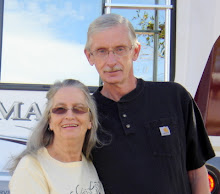We met here at tour headquarters, checked in and toured this site, and watched a short documentary on the Manhattan Project. The B Reactor produced plutonium for the first atomic explosion, which ultimately helped to bring an end to World War II.
The docent explained what we will see today. The B Reactor is one of nine reactors built along the Columbia River. It was a top secret project, the workers had no idea they were building the first atomic bomb.
When the government was looking for a place to build these reactors, this part of Washington State was perfect. It required a very large remote setting with sparse population, abundant cold water, dependable hydroelectric power source, convenient access to railroad and highway facilities, a relative flat landscape, available fuel and concrete aggregate. The Columbia River was the key ingredient. It was time to board the bus.
You could see the other Reactors off in the distance.
We went through a "Secret Gate" to get to B Reactor.
Today we will see the front face of B Reactor.
B Reactor, the first of it's kind.
It looked menacing!
What an engineering marvel!
We were allowed to tour the site on our own. It was interesting to see all the signs from that era.
We toured the control room and the docent explained the workings.
So many knobs and valves.
I was finally in Control!
The first atomic bomb was exploded at 5:30 A.M. on July 16, 1945 on the Alamogordo, New Mexico Air Base. The following month two other atomic bombs were dropped on Hiroshima and Nagasaki, Japan. The B Reactor produced plutonium for more than twenty years. Most of the reactors were shut down between 1964 and 1971.The B Reactor was permanently shut down in February 1968 and scheduled to be "cocooned", like the other reactors. "Cocooning" is a process by which the reactor is encased in a concrete shell for 75 years to allow the radioactivity to decay away .However, in August 2008, the United States Department of the Interior designated the B Reactor as a National Historic Landmank.
Decades of manufacturing left behind 53 million gallons of high-level radioactive waste and 25 million cubic feet of solid radioactive waste, and 200 square miles of contaminated groundwater beneath the site. Hanford is currently the most contaminated nuclear site in the United State and is the nation's largest environmental cleanup. There are currently 6,000 workers employed.
We were allowed to tour the site on our own. It was interesting to see all the signs from that era.
We toured the control room and the docent explained the workings.
So many knobs and valves.
I was finally in Control!
The first atomic bomb was exploded at 5:30 A.M. on July 16, 1945 on the Alamogordo, New Mexico Air Base. The following month two other atomic bombs were dropped on Hiroshima and Nagasaki, Japan. The B Reactor produced plutonium for more than twenty years. Most of the reactors were shut down between 1964 and 1971.The B Reactor was permanently shut down in February 1968 and scheduled to be "cocooned", like the other reactors. "Cocooning" is a process by which the reactor is encased in a concrete shell for 75 years to allow the radioactivity to decay away .However, in August 2008, the United States Department of the Interior designated the B Reactor as a National Historic Landmank.
Decades of manufacturing left behind 53 million gallons of high-level radioactive waste and 25 million cubic feet of solid radioactive waste, and 200 square miles of contaminated groundwater beneath the site. Hanford is currently the most contaminated nuclear site in the United State and is the nation's largest environmental cleanup. There are currently 6,000 workers employed.























No comments:
Post a Comment
Note: Only a member of this blog may post a comment.